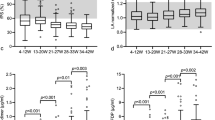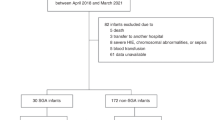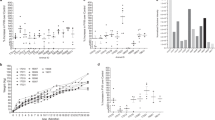Abstract
Summary: Evidence of developmental evolution of coagulation can be seen when the studies of 10 thriving extremely premature (EPT) infants are compared to normal full-term (FT) infants. The prothrombin time, partial thromboplastin time, and thrombin time all became shorter with increasing gestational age. Fibrinogen levels and platelet counts appear to be comparable to term infant and adult levels. Fibrin degradation products (FDP) of 10 μg/ml or less were found in the thriving EPT infants. When compared to healthy full-term infants, there is a definite gestational dependency of anti-thrombin III levels. Factors II and VII appear to be related to intrauterine maturation after the age of viability (24 wk), but factor VII-X complex does not. The contact factors XI, XII, high molecular weight kininogen (Fitzgerald factor), and prekallikrein (Fletcher factor) are all markedly decreased in thriving EPT infants. The mean factor V level is lower than that found in FT infants. This study confirms a gestational age dependency of factor VIII activity. The ratio of factor VIII antigen to factor VIII clotting activity is increased (2.8 vs 1.01 in FT and adults). Thriving small for gestational age (SGA) infants had coagulation studies which were not statistically different from those of thriving EPT infants. The coagulation changes which occurred in severely ill EPT were mainly in the factors which decrease during intravascular coagulation (factors I, V, and VIII). The present study suggests that because of the high antigen to activity ratio seen in thriving EPT infants, a dysfunctional or fetal factor VIII may have been produced. However, the further elevation of this ratio in the severely ill EPT infants is in keeping with a pathologic proteolysis or increased endothelial release of factor VIII antigen.
Speculation: Prevention of and prompt therapeutic intervention for asphyxia, sepsis, hypovolemia, hypotension, hypothermia, hypoxia, and acidosis may prevent the occurrence of the coagulation changes seen in the severely ill EPT infants. A distinction between abnormal proteolysis versus production of dysfunctional proteins is essential before specific therapies can be designed.
Similar content being viewed by others
Log in or create a free account to read this content
Gain free access to this article, as well as selected content from this journal and more on nature.com
or
Author information
Authors and Affiliations
Rights and permissions
About this article
Cite this article
Barnard, D., Simmons, M. & Hathaway, W. Coagulation Studies in Extremely Premature Infants. Pediatr Res 13, 1330–1335 (1979). https://doi.org/10.1203/00006450-197912000-00006
Issue date:
DOI: https://doi.org/10.1203/00006450-197912000-00006
Keywords
This article is cited by
-
Predicting neonatal mortality with a disseminated intravascular coagulation scoring system
International Journal of Hematology (2023)
-
Risk factors and treatments for disseminated intravascular coagulation in neonates
Italian Journal of Pediatrics (2020)
-
The coagulation system of extremely preterm infants: influence of perinatal risk factors on coagulation
Journal of Perinatology (2012)
-
Routine coagulation tests in newborn and young infants
Journal of Thrombosis and Thrombolysis (2007)



